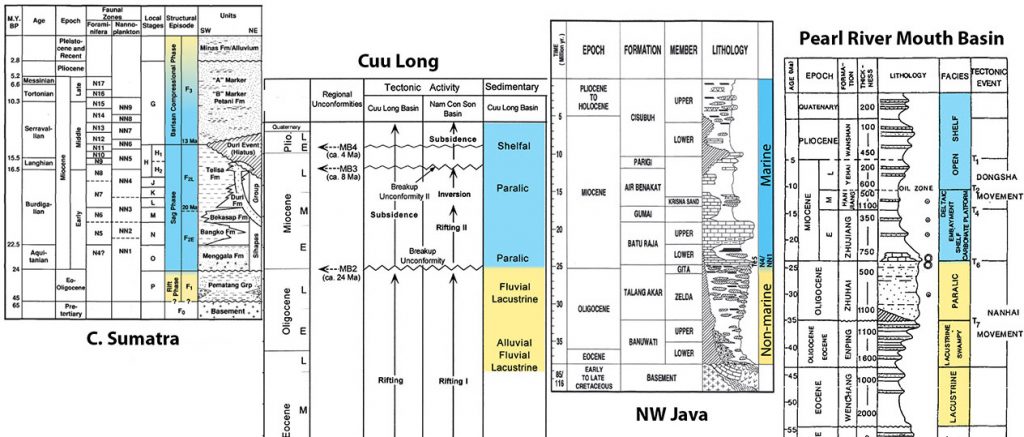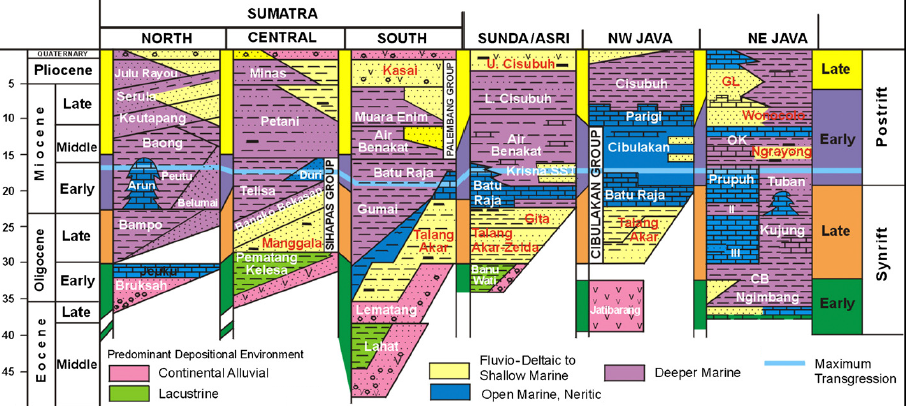Why tectono-stratigraphic sequence boundaries must correlate
A question from recent emails (and, as covid lockdown eased, old-fashioned meetings) about the blog has been on the validity of the tectono-stratigraphic unconformities as primary sequence boundaries. The following mostly applies to the multiple extensional events that dominated the stratigraphy of Sundaland from about 40 to 15 Ma.
When sudden, break-up type unconformities affected Sundaland they are usually recorded as a very dramatic subsidence in the axial areas that fades in magnitude laterally. On the flanks, the deposition of subsequent sediments may be slightly diachronous (debatable in many cases) but the subsidence event seems to have been a single instance in time, based on the best age dating tools we have.
There is an important application of Walther’s Law to help understand what these periods of sudden change mean, and how they should be used to construct a stratigraphic history. Walther’s Law of course states that facies in a sedimentary system that are adjacent at one time will stack up in the same order in sections during times of gradual transgression or regression.

This Law is so obvious we tend to forget it. However, at many times and in many places around SE Asia we encounter long periods of relative stasis then a step, often at a single wireline log break in a well, below the resolution of 30 ft drill-cutting samples, followed by long periods of very much deeper facies. These abrupt shift in facies I have termed non-Waltherian contacts, as most classifications of unconformities are biassed to reflect bedding angles, not facies change.
These stepped facies contrasts (figure above, right) imply a geographic history that cannot be gradual. There is a chance that a highly condensed gradual succession is preserved in the few metres around the contact but, in the context of the prolonged previous and subsequent sedimentary stability, the stepped succession betrays an abrupt shift in palaeogeography. This is Walther’s Law.
This step means that if a fluvio-deltaic system has withdrawn from an area due to rapid subsidence, then in that depocentre there cannot be a location where part of the delta top was “left behind”. It is possible that faulting was active at the time of change and this could could have produced new highs, but a part of a delta could not have survived on top of these highs, unaffected. The delta is a system, connecting fluvial to bathyal sedimentary settings. It moves and re-arranges as a whole system. So viewed at a scale that recognised the step, it can be said that in this succession Walther’s Law is broken, even if bedding remained flat and apparently conformable
In tectonically passive margins it is unlikely to have such a sudden eustatic or epeirogenic sea-level rise rapidly increasing the accommodation space. Along such margins non-Waltherian contacts (NWCs) are usually seen at the maximum regressive surfaces where the facies were rapidly shifted distally, and the sequence boundary and facies contrast is exaggerated by slight erosion in the proximal areas. The existence of multiple, stepped and strongly transgressive non-Waltherian contacts in South East Asian well sections is a primary indication that stratigraphy in the area was driven by tectonics, as these features are not present in the idealised models developed from passive margin sequence stratigraphy.
If it is suspected that tectonism has driven stratigraphy, a new method is needed to study sedimentation and make a predictive framework. The model of passive margin sequence stratigraphy has a dominant proximal to distal dimension, so at a sequence boundary the facies migrated along that dimension (ignoring, for now, autocyclic lobe migration into and out of the plane of section). If tectonism has controlled accommodation space, then all bets are off. The basin can re-form in any new shape in three dimensions. There is no ideal model to guide us, and the study of facies contrast, and faults on seismic, are very important factors to determine the palaeogeography both before and after the event. The facies contrast becomes a new topic of research and it is heavily reliant on microfaunal indications of environment of deposition, as well as lithofacies and sedimentology (assessed quantitatively using geohistory analysis).
In the past many studies have overlooked this fundamental shift in work-flow, and the identify of the non-Waltherian contacts as primary sequence boundaries has been overlooked. I often see correlations forced to a seismic mis-pick, wireline log shift, or an unreliable biostratigraphic datum (or isotopic age; see examples in the post on precision and trueness) whereby some part of the pre NWC section is misplaced into the post NWC correlation and palaeogeography. Such work has broken Walther’s Law and is simply invalid. Just as perpetual motion machines break the first and second laws of thermodynamics.
As noted above the subsidence events seem to correlate widely over the flanks. Perhaps the best example of this is the event on the Oligo-Miocene boundary that saw the onset of marine sedimentation in many Sundaland basins at the same time, and hence the transgression can be dated using marine microfossils. Below the event are often thick non-marine deposits, maybe very rarely with a thin paralic or inner neritic flood, but a consistent facies-suite lacking significant marine influences. After the Oligo-Miocene boundary event the sediments remained fully marine for extended periods, often represented by thick sections. There is a stepped change like this in the Malay, West Natuna, Nam Con Son, Cuu Lon, Phu Khanh, Pearl River Mouth Basin, offshore Sarawak, west and east Java Sea, south Sumatra and central Sumatran basins. In these areas the transgressive event is only a shift in the order of a few tens of metres increased accommodation space, but at a large scale it has a step-like profile, and the event correlates to the massive Oligo-Miocene boundary subsidence events in the Makassar Straits (see this link, and the geohistory plot at the end of this post) and central South China Sea (with true plate break-up in the latter site; see the North Luconia geohistory plot in this post)

A new work-flow
This new methodology is an inductive or heuristic approach; a general strategy or method for solving problems that is evidence-based rather than model-driven. This is needed because the models developed on passive margins have little predictive power in the tectonically active basins of South East Asia. The heuristic approach can also be applied to the compressional phase of basin modification that began gradually in the later part of the Early Miocene. In fact, the very realisation that there was a prolonged extensional phase, transitioning to a compressional phase in the later Early Miocene, was only recognised by applying evidence-based approaches and geohistory analysis. Until then the Oligo-Miocene boundary had been considered the end of the “rift” phase and start of a “sag” phase, based on model-driven expectations. The Sunda-wide acceleration of subsidence at the Oligo-Miocene boundary unconformity is the reverse of the expected deceleration from active rifting to thermal sag.

Above is a traditional view of Sundaland basins (Doust & Noble, 2008) that assumes sediment accommodation space was controlled by rift to sag basin processes with a eustatic sea-level control superimposed. The orange coloured bars highlight the periods interpreted as the late synrift phase, and all these terminated at the Oligo-Miocene boundary (when biostratigraphy is examined for aspects of precision and accuracy). However, instead of “sag” taking over, which would have extended the width of the basin by thermal cooling of the lower lithosphere around the narrower crustal rifts (the “Steer’s Head” tectonic model; White and McKenzie, 1988), the rate of subsidence actually accelerated.
The light blue correlation line on the figure above is not, as claimed, a eustatic sea-level high related to an end Early Miocene climatic optimum, but the continuation of tectonic subsidence until, at slightly different times in different areas, there was termination of extension by compression. This compression was driven by the impinging Australian and Philippines plates in the southeast and northeast. Remember, Sundaland was widely attenuated, subsided and was transgressed from later Middle Eocene through end Early Miocene times while global sea-levels were falling.
References
Doust, H., Noble, R.A., 2008. Petroleum systems of Indonesia. Marine and Petroleum Geology 25, 103-129
White, N., McKenzie, D., 1988. Formation of the “steer’s head” geometry of sedimentary basins by differential stretching of the crust and mantle. Geology 16, 250-253
Be First to Comment